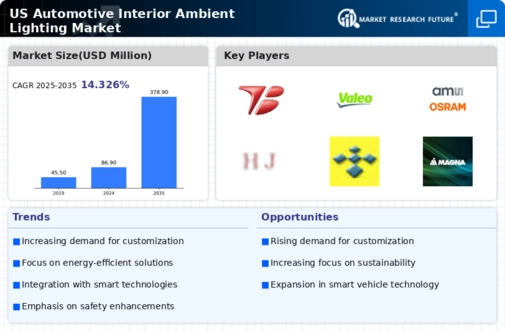Increased Focus on Safety Features
The automotive interior-ambient-lighting market is also shaped by an increased focus on safety features in vehicle design. Ambient lighting plays a crucial role in enhancing visibility and creating a safer driving environment. For instance, strategically placed lighting can help illuminate controls and displays, reducing the risk of distractions. Moreover, ambient lighting can be utilized to signal important alerts to drivers, thereby improving overall safety. As safety regulations become more stringent, automakers are likely to invest in advanced lighting solutions, further propelling the automotive interior-ambient-lighting market.
Consumer Preference for Smart Features
Consumer preference for smart features in vehicles is a driving force behind the automotive interior-ambient-lighting market. As vehicles become increasingly connected, ambient lighting systems are being integrated with smart technologies, allowing for voice control and app-based customization. This integration enhances user experience and aligns with the growing trend of smart home technology. Approximately 45% of consumers express interest in vehicles that offer smart lighting features, indicating a strong market potential. Consequently, automakers are likely to prioritize the development of intelligent ambient lighting solutions, further stimulating growth in the automotive interior-ambient-lighting market.
Growing Popularity of Electric Vehicles
The growing popularity of electric vehicles (EVs) significantly impacts the automotive interior-ambient-lighting market. As EV manufacturers strive to differentiate their products, they often incorporate innovative interior features, including advanced ambient lighting systems. These systems not only enhance the aesthetic appeal of EVs but also align with the eco-friendly ethos of electric mobility. Market data indicates that the EV segment is projected to grow at a CAGR of over 20% in the coming years, suggesting a substantial opportunity for the automotive interior-ambient-lighting market to expand alongside this trend.
Technological Advancements in LED Lighting
Technological advancements in LED lighting significantly influence the automotive interior-ambient-lighting market. The transition from traditional lighting systems to LED technology offers numerous advantages, including energy efficiency, longevity, and versatility in design. LEDs consume up to 75% less energy than incandescent bulbs, making them an attractive option for automakers aiming to enhance vehicle efficiency. Furthermore, the ability to produce a wide spectrum of colors allows for greater customization, appealing to consumers' desires for unique interior environments. As a result, the automotive interior-ambient-lighting market is likely to witness continued growth driven by these technological innovations.
Rising Consumer Demand for Enhanced Aesthetics
The automotive interior-ambient-lighting market experiences a notable surge in consumer demand for enhanced aesthetics within vehicles. As consumers increasingly seek personalized experiences, automakers are integrating sophisticated ambient lighting systems to create visually appealing interiors. This trend is particularly pronounced among younger demographics, who prioritize style and ambiance. According to recent data, approximately 60% of consumers express a preference for vehicles equipped with customizable lighting options. This growing inclination towards aesthetic enhancements drives manufacturers to innovate and invest in advanced lighting technologies, thereby propelling the automotive interior-ambient-lighting market forward.



















Leave a Comment